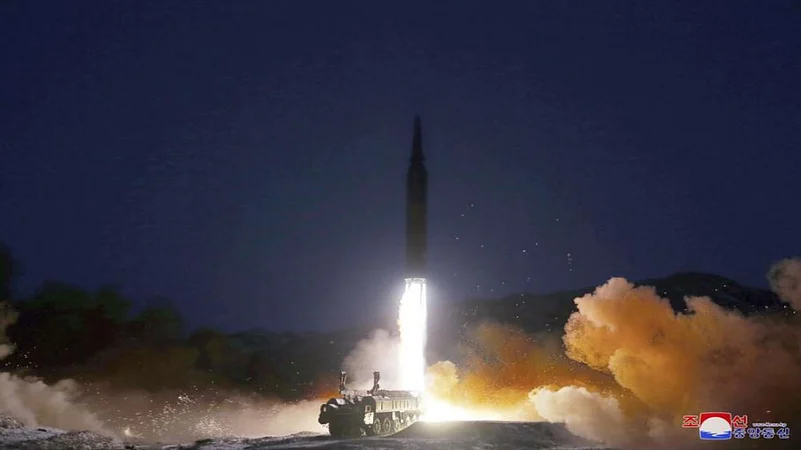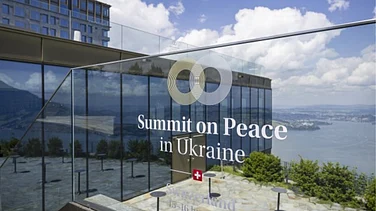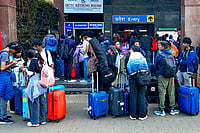North Korea confirmed Monday it test-launched an intermediate-range ballistic missile capable of reaching the US territory of Guam, the North's most significant weapon launch in years, as Washington plans to show its commitment to its Asian allies with an unspecified move.
Sunday's launch could be a prelude to bigger provocations by North Korea such as nuclear and long-range missile tests that pose a direct threat to the US mainland, as the North is ramping up pressure on the Biden administration amid stalled nuclear diplomacy.
Some experts say North Korea's recent testing spree is meant to win sanction relief or an international recognition as a legitimate nuclear state in the face of pandemic-related difficulties and persistent US-led sanctions.
They say North Korea could conduct bigger tests if it's slapped with new sanctions over Sunday's launch.
The official Korean Central News Agency said the purpose of the test was verifying the overall accuracy of the Hwasong-12 missile that is being deployed in its military.
KCNA published two sets of combination photos — one showing the missile rising from a launcher and soaring into space and the other showing North Korea and nearby areas that it said were photographed by a camera installed at the missile's warhead.
The Associated Press decided not to use the images because the authenticity of the photos couldn't be verified.
North Korea said the missile was launched toward the waters off its east coast and on a high angle to prevent it from overflying other countries. It gave no further details.
According to South Korean and Japanese assessment, the missile flew about 800 kilometers (497 miles) and reached a maximum altitude of 2,000 kilometers (1,242 miles) before landing in the waters between the Korean Peninsula and Japan.
The reported flight details make it the most powerful missile North Korea tested since 2017, when the country launched Hwasong-12 and longer-range missiles in a torrid run of weapons firings to acquire an ability to launch nuclear strikes on US military bases in North Asia and the Pacific and even the American homeland.
The Hwasong-12 missile is a nuclear-capable ground-to-ground weapon, whose maximum range is 4,500 kilometers (2,800 miles) when it's fired on a standard trajectory. It's a distance sufficient to reach the US territory of Guam. In August 2017, at the height of animosities with the then-Trump administration, North Korea's Strategic Forces threatened to make “an enveloping fire” near Gaum with Hwasong-12 missiles.
In 2017, North Korea also test-fired intercontinental ballistic missiles called Hwasong-14 and Hwasong-15 that experts say demonstrated their potential capacity to reach the mainland US.
In recent months, North Korea has launched a variety of weapons systems and threatened to lift a four-year moratorium on more serious weapons tests such as nuclear explosions and ICBM launches. Sunday's launch was the North's seventh round of missile launches in January alone, and other weapons tested recently include a developmental hypersonic missile and a submarine-launched missile.
Some experts say the boosted testing activity shows how North Korean leader Kim Jong Un is determined to modernize his weapons arsenals despite pandemic-caused hardships and US-led international sanctions. They say Kim also likely aims to pressure the Biden administration to ease sanctions or accept it as a nuclear weapons state.
Analyst Cheong Seong-Chang at the private Sejong Inistitute in South Korea said North Korea's Hwaseong-12 launch was seen as partially breaking the weapons test moratorium. In April 2018, when North Korea announced a suspension of nuclear and ICBM tests ahead of now-dormant diplomacy with the Trump administration, Kim said North Korea didn't need to test intermediate-range missiles as well.
Cheong said North Korea will likely test-launch its existing long-range missile if the United States spearheads fresh sanctions on it. Other experts said North Korea could conduct a nuclear test as well.
After Sunday's launch, White House officials said they saw the latest missile test as part of an escalating series of provocations over the last several months that have become increasingly concerning.
The Biden administration plans to respond to the latest missile test in the coming days with an unspecified move meant to demonstrate to the North that it is committed to allies' security in the region, according to a senior administration official who briefed reporters on the condition of anonymity.
The official said the administration viewed Sunday's missile test as the latest in a series of provocations to try to win sanctions relief from the US.
The Biden administration again called on North Korea to return to talks but made clear it doesn't see the sort of leader-to-leader summits Donald Trump held with Kim as constructive at this time.
South Korean and Japanese officials also condemned Sunday's launch, which violated UN Security Council resolutions that bans the country from testing ballistic missiles and nuclear weapons.
South Korean President Moon Jae-in said Sunday's missile launch brought North Korea to the brink of breaking its 2018 self-imposed weapons test moratorium.
US-led diplomacy aimed at convincing North Korea to abandon its nuclear program largely remains stalled since a second summit between Kim and Trump collapsed in early 2019 due to disputes over US-led sanctions on the North.
Observers say North Korea could halt its weapons tests after the Beijing Winter Games begin Friday because China is its most important ally and aid benefactor.
But they say North Korea could test bigger weapons when the Olympics end and the US and South Korean militaries begin their annual springtime military exercises.





















